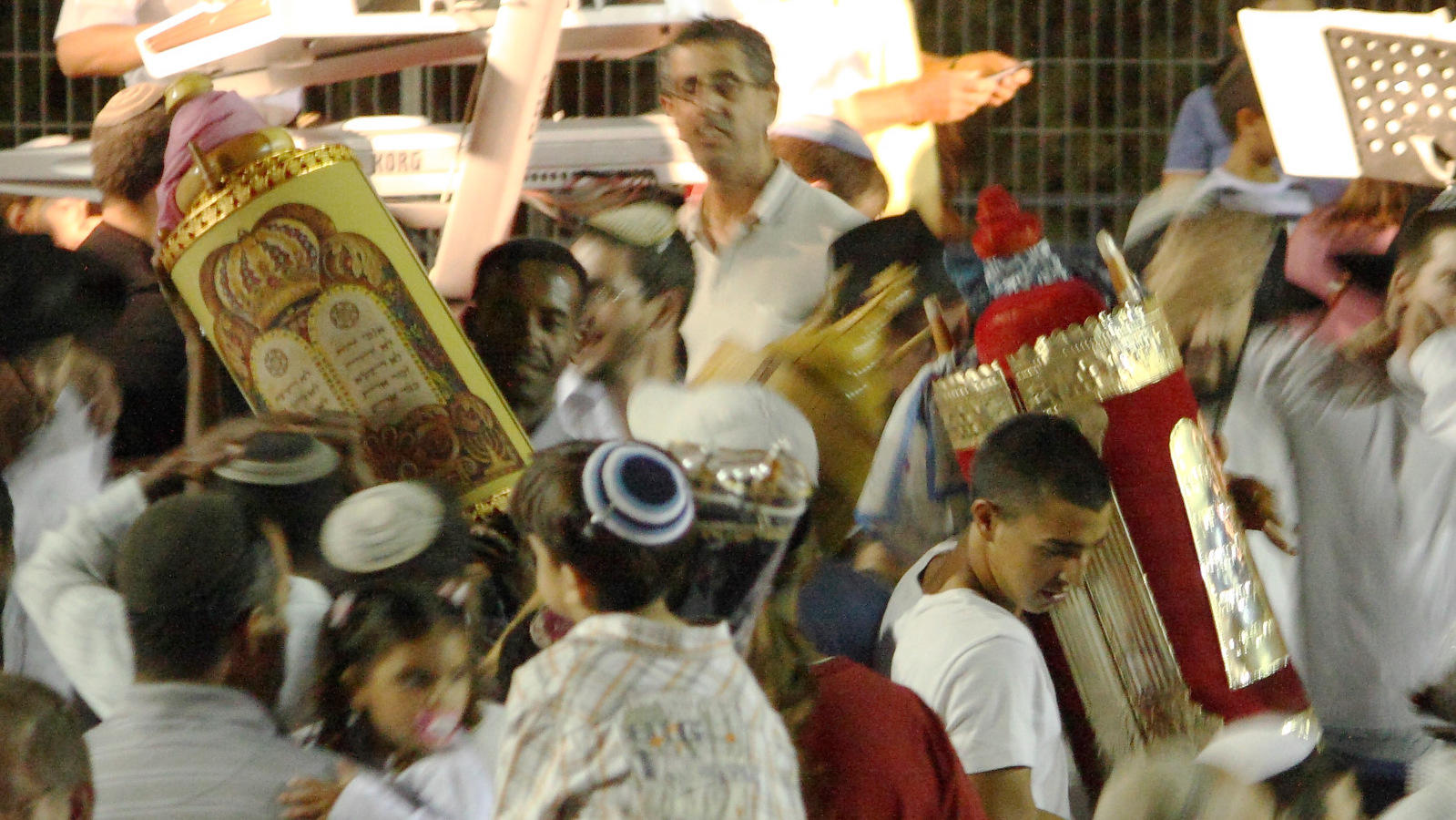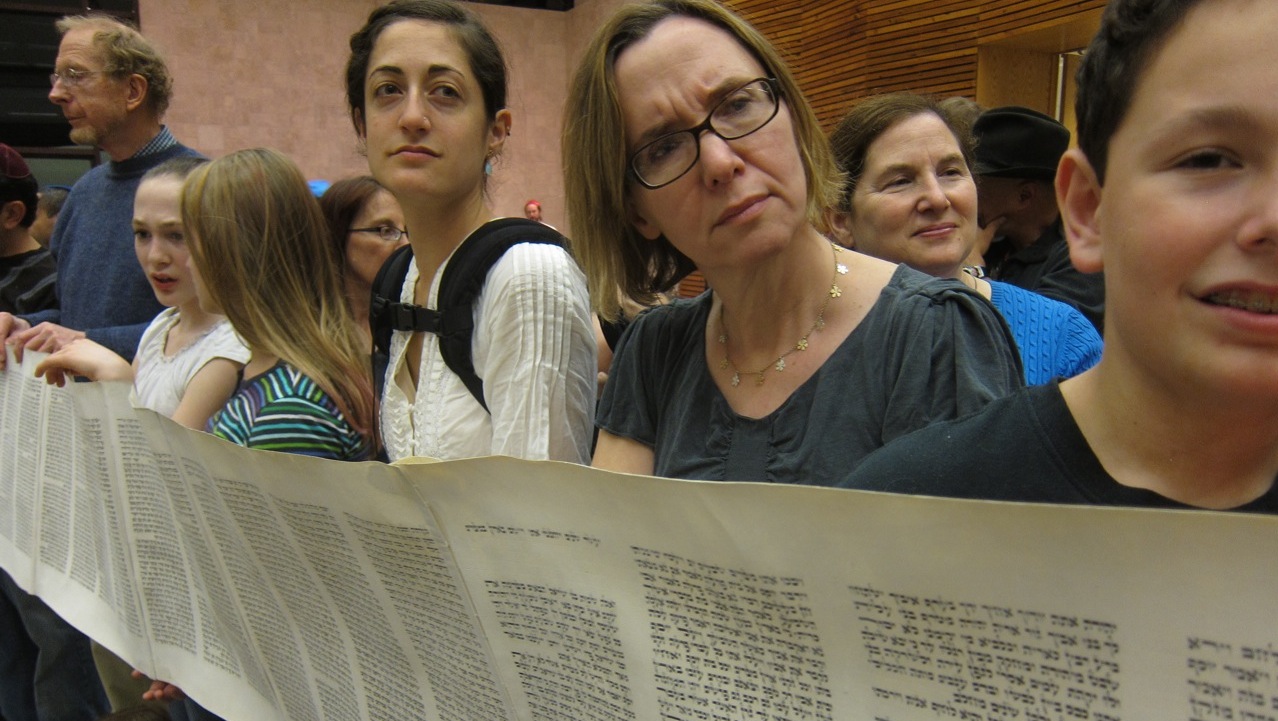When Does the Torah Start Again
Every seventh year…at the Feast of Booths (Sukkot)…you lot shall read this Education aloud in the presence of all Israel. (Deuteronomy 31:x-12).
In much of the Diaspora (the Jewish communities outside the State of Israel), Shemini Atzeret (the eighth day of Sukkot) is followed directly by a 2nd special day, Simchat Torah (literally, "joy of the Torah"). In Israel and in most Reform congregations, nevertheless, all of the observances for Simchat Torah are held on Shemini Atzeret, combining the 2 holidays into one twenty-four hour period and making them almost indistinguishable. Simchat Torah itself is the celebration dedicated to both completing the yearly cycle of public Torah reading and starting it again.
The get-go mention of such a wheel appears in the Bible, in Deuteronomy, where Moses instructs the tribe of Levi and the elders of Israel to gather all the people for a public reading from portions of the Torah once every 7 years. The need to read the Torah publicly intensified later on the destruction of the 2nd Temple in lxx CE; Jews were dispersed into other parts of the Middle East, into Due north Africa, and into Europe; and their earlier religious and cultural world became decentralized. While most Jews in the Diaspora now follow one Torah-reading bicycle, some communities are on a triennial cycle. (More than nigh that beneath.)
Dancing and Merriment on Simchat Torah

Observance of Simchat Torah begins with the evening service. Information technology provides, in addition to the regular festival liturgy, a special Torah service in which the final Torah portionof the year is read. Before the reading itself begins, selected congregants have all of the Torah scrolls from the ark and parade them around the synagogue. They make 7 of these hakafot (circuits), which are performed with joy and accompanied past drinking, singing and dancing.
The festivities for Simchat Torah go along the side by side forenoon with seven more than hakafot. Children are particularly involved in this merrymaking and are often given paper flags to carry in the processional. The Torah reading that day is drawn from three scrolls. From the first scroll, we read the final portion of Deuteronomy and from the second, the first portion of Genesis. Thus, when we finish the Torah with the final book, Deuteronomy, we immediately begin again with the first volume, Genesis, to symbolize that Torah never ends and that we never consummate our learning. From the tertiary scroll nosotros read the maftir (the passage that concludes the Torah reading). For Simchat Torah, the maftir is from Numbers (Numbers 29:35-30:i), almost observing Shemini Atzeret.
Aliyahs for Everyone

An aliyah (plural, aliyot) is the award of being called upon to brand one set of the blessings said before and later each department of the Torah reading. Customarily, on Simchat Torah, everyone in the congregation receives an aliyah; and so it is common to have both individuals and groups of people called upward at once.
Three of the aliyahs are particular honors. The first of these most-honored aliyahs is the next-to-concluding 1 for the reading of Deuteronomy that completes the annual wheel of Torah readings. This aliyah is identified equally Kol Ha-Ne'arim (literally, "All the Children"), because information technology is given to a distinguished member of the community, joined on the bimah by all of the children present. The developed honoree holds aloft a prayer shawl forming a canopy higher up the children. In unison, the honoree and the children say the blessings before and later on this reading. And so the entire congregation blesses all the children by reciting the blessing Jacob gave to his grandchildren. In this moment of Simchat Torah, nosotros see a parallel betwixt the unbroken cycle of Torah reading and the never-catastrophe transmission of Torah from generation to generation.
The second very special laurels is the final aliyah for this reading from Deuteronomy. The aliyah is designated as the Hatan Torah or Kallat Torah (literally, "Benedict of the Torah" or "Bride of the Torah"), and the honor is reserved for someone of great stardom in the community, such as the rabbi.
The third special honor is the aliyah for the Torah reading that begins the new annual cycle — the one at the very beginning of Genesis. The recipient of that aliyah is designated Hatan Bereishit or Kallat Bereishit (literally, "Bridegroom of Genesis" or "Helpmate of Genesis"). Some congregations have a custom to spread a tallit (prayer shawl) over the Hatan/Kallat Torah and Hatan/Kallat Bereishit, similar to making a awning over the children.
More Well-nigh the Torah-Reading Cycle
Because a reference in the Mishnah (the offset effort to permanently record Jewish custom and constabulary, compiled in the 3rd century C.E.) supported Deuteronomy'south prescription, we sympathize that Jews were continuing to read the Torah publicly; and we too know that there were Torah readings for festivals, special Shabbatot (plural of Shabbat) and fast days.
But it was not until the Talmudic era, about the sixth century C.Eastward., that the Jews in the State of Israel began to read the entire Torah in public and do so until all the Five Books of Moses were completed. At that time, the wheel took three years in a pattern chosen the Palestinian triennial, outset the offset twelvemonth with the kickoff book, Genesis, and finishing, at the end of the third year, with the 5th book, Deuteronomy.
The Jews of Babylon, however, followed a different custom, established past the showtime of the 7th century CE, and completed the entire cycle each year, which they did by dividing the Torah into 54 weekly portions. (Because the number of portions exceeds the number of weeks in a given year, more than than ane portion is read during sure weeks.) In Hebrew, the give-and-take for portion is parsha(plural, parshiyot).
In the 19th century, a reintroduction of the Palestinian triennial bike was attempted at the Westward Stop Congregation in London, just was unsuccessful. In the middle of the 20th century, various congregations in the Usa (primarily Conservative ones) were seeking ways to modernize the service and also to spend more time on Shabbat on Torah report. They too attempted to revive the Palestinian cycles with the statement that reading only a section of the weekly Torah portion would make Torah study more than full-bodied and thus enhanced.
The reintroduction failed for two reasons. First, in the pattern of the Palestinian triennial cycle, the weekly reading would take differed from what the remainder of the Jewish world was reading. 2d, Simchat Torah celebrations would only occur one out of every three years, instead of annually.
Finally, in 1988, the Committee on Jewish Law and Standards of the Conservative Move passed a legal responsum that put into practise a new American triennial bike. This new triennial cycle, rather than dividing the entire Torah into thirds, as was done in the Palestinian bike, divides each of the individual 54 portions into thirds. Therefore, a congregation can exist reading inside the same portion equally those who follow the annual bike, but will merely read 1-third of each portion per year. In addition, this design enables the congregation to read from Genesis through Deuteronomy each year, providing for an annual celebration of Simchat Torah.
At that place is an obvious drawback to this arrangement: Only one-third of each conventional Torah portion is actually read per twelvemonth; and the readings, because incomplete, do not catamenia smoothly into the portion of the following calendar week. However, the vast bulk of American Conservative and Reform congregations prefer this new cycle. All Jews in State of israel, however, and Orthodox Jews in America continue to follow the annual cycle with the full portion read each week.
Reprinted with permission from Celebrating the Jewish Year (Jewish Publication Social club).
Source: https://www.myjewishlearning.com/article/the-torah-service-for-simchat-torah/
0 Response to "When Does the Torah Start Again"
Postar um comentário